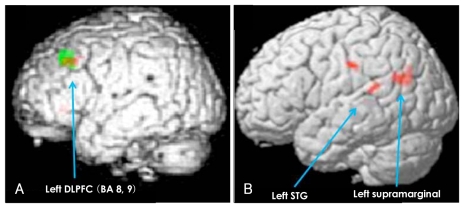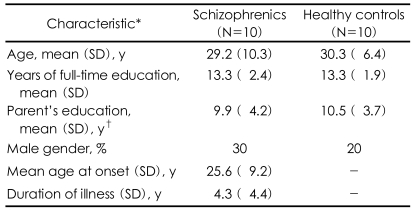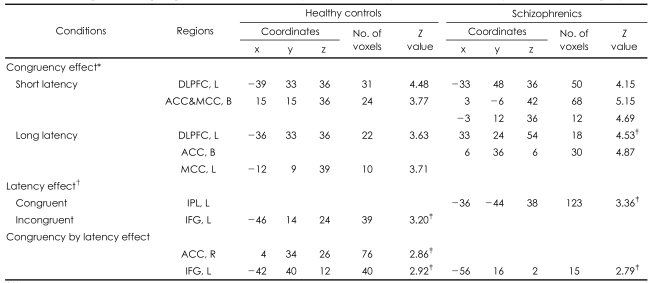2. Boucart M, Mobarek N, Cuervo C, Danion JM. What is the nature of increased Stroop interference in schizophrenia? Acta Psychol (Amst) 1999;101:3-25. PMID:
10100453.


3. Carter CS, Mintun M, Nichols T, Cohen JD. Anterior cingulate gyrus dysfunction and selective attention deficits in schizophrenia: [15O] H2O PET study during single-trial Stroop task performance. Am J Psychiatry 1997;154:1670-1675. PMID:
9396944.



4. Nordahl TE, Carter CS, Salo RE, Kraft L, Baldo J, Salamat S, et al. Anterior cingulate metabolism correlates with stroop errors in paranoid schizophrenia patients. Neuropsychopharmacology 2001;25:139-148. PMID:
11377927.


5. Y├╝cel M, Pantelis C, Stuart GW, Wood SJ, Maruff P, Velakoulis D, et al. Anterior cingulate activation during Stroop task performance: a PET to MRI coregistration study of individual patients with schizophrenia. Am J Psychiatry 2002;159:251-254. PMID:
11823267.


6. MacDonald AW 3rd, Cohen JD, Stenger VA, Carter CS. Dissociating the role of the dorsolateral prefrontal and anterior cingulate cortex in cognitive control. Science 2000;288:1835-1838. PMID:
10846167.


7. Carter CS, Macdonald AM, Botvinick M, Ross LL, Stenger VA, Noll D, et al. Parsing executive processes: strategic vs. evaluative functions of the anterior cingulate cortex. Proc Natl Acad Sci U S A 2000;97:1944-1948. PMID:
10677559.



8. Perlstein WM, Dixit NK, Carter CS, Noll DC, Cohen JD. Prefrontal cortex dysfunction mediates deficits in working memory and prepotent responding in schizophrenia. Biol Psychiatry 2003;53:25-38. PMID:
12513942.


9. Ceccherini-Nelli A, Crow TJ. Disintegration of the components of language as the path to a revision of Bleuler's and Schneider's concepts of schizophrenia. Linguistic disturbances compared with first-rank symptoms in acute psychosis. Br J Psychiatry 2003;182:233-240. PMID:
12611787.


10. Ceccherini-Nelli A, Turpin-Crowther K, Crow TJ. Schneider's first rank symptoms and continuous performance disturbance as indices of dysconnectivity of left- and right-hemispheric components of language in schizophrenia. Schizophr Res 2007;90:203-213. PMID:
17113266.


11. American Psychiatric Association. Diagnostic and Statistical Manual of Mental Disorders. 1994,4th ed. Washington, DC: American Psychiatric Press.
12. Kay SR, Fiszbein A, Opler LA. The positive and negative syndrome scale (PANSS) for schizophrenia. Schizophr Bull 1987;13:261-276. PMID:
3616518.



13. Oldfield RC. The assessment and analysis of handedness: the Edinburgh inventory. Neuropsychologia 1971;9:97-113. PMID:
5146491.


14. Perlstein WM, Carter CS, Noll DC, Cohen JD. Relation of prefrontal cortex dysfunction to working memory and symptoms in schizophrenia. Am J Psychiatry 2001;158:1105-1113. PMID:
11431233.


15. Dale AM. Optimal experimental design for event-related fMRI. Hum Brain Mapp 1999;8:109-114. PMID:
10524601.



16. Egner T, Hirsch J. The neural correlates and functional integration of cognitive control in a Stroop task. Neuroimage 2005;24:539-547. PMID:
15627596.


17. Maldjian JA, Laurienti PJ, Kraft RA, Burdette JH. An automated method for neuroanatomic and cytoarchitectonic atlas-based interrogation of fMRI data sets. Neuroimage 2003;19:1233-1239. PMID:
12880848.


18. Barch DM, Carter CS, Braver TS, Sabb FW, MacDonald A 3rd, Noll DC, et al. Selective deficits in prefrontal cortex function in medication-naive patients with schizophrenia. Arch Gen Psychiatry 2001;58:280-288. PMID:
11231835.


19. Volz H, Gaser C, H├żger F, Rzanny R, P├Čnisch J, Mentzel H, et al. Decreased frontal activation in schizophrenics during stimulation with the continuous performance test--a functional magnetic resonance imaging study. Eur Psychiatry 1999;14:17-24. PMID:
10572321.


20. Catani M, Jones DK, ffytche DH. Perisylvian language networks of the human brain. Ann Neurol 2005;57:8-16. PMID:
15597383.


21. Croxson PL, Johansen-Berg H, Behrens TE, Robson MD, Pinsk MA, Gross CG, et al. Quantitative investigation of connections of the prefrontal cortex in the human and macaque using probabilistic diffusion tractography. J Neurosci 2005;25:8854-8866. PMID:
16192375.



22. Petrides M, Pandya DN. Comparative cytoarchitectonic analysis of the human and the macaque ventrolateral prefrontal cortex and corticocortical connection patterns in the monkey. Eur J Neurosci 2002;16:291-310. PMID:
12169111.


23. Kubicki M, McCarley RW, Nestor PG, Huh T, Kikinis R, Shenton ME, et al. An fMRI study of semantic processing in men with schizophrenia. Neuroimage 2003;20:1923-1933. PMID:
14683698.



24. Han SD, Nestor PG, Hale-Spencer M, Cohen A, Niznikiewicz M, McCarley RW, et al. Functional neuroimaging of word priming in males with chronic schizophrenia. Neuroimage 2007;35:273-282. PMID:
17215145.



25. Weiss EM, Siedentopf C, Golaszewski S, Mottaghy FM, Hofer A, Kremser C, et al. Brain activation patterns during a selective attention test--a functional MRI study in healthy volunteers and unmedicated patients during an acute episode of schizophrenia. Psychiatry Res 2007;154:31-40. PMID:
17188464.


26. Jones HM, Brammer MJ, O'Toole M, Taylor T, Ohlsen RI, Brown RG, et al. Cortical effects of quetiapine in first-episode schizophrenia: a preliminary functional magnetic resonance imaging study. Biol Psychiatry 2004;56:938-942. PMID:
15601603.


27. Becker TM, Kerns JG, Macdonald AW 3rd, Carter CS. Prefrontal Dysfunction in First-Degree Relatives of Schizophrenia Patients during a Stroop Task. Neuropsychopharmacology 2008;In press.


28. Brewer WJ, Y├╝cel M, Harrison BJ, McGorry PD, Olver J, Egan GF, et al. Increased prefrontal cerebral blood flow in first-episode schizophrenia following treatment: longitudinal positron emission tomography study. Aust N Z J Psychiatry 2007;41:129-135. PMID:
17464690.


29. Ehlis AC, Herrmann MJ, Pauli P, Stoeber G, Pfuhlmann B, Fallgatter AJ. Improvement of prefrontal brain function in endogenous psychoses under atypical antipsychotic treatment. Neuropsychopharmacology 2007;32:1669-1677. PMID:
17203015.



30. Gonz├Īlez-Blanch C, Alvarez-Jim├®nez M, Rodr├Łguez-S├Īnchez JM, P├®rez-Iglesias R, V├Īzquez-Barquero JL, Crespo-Facorro B. Cognitive functioning in the early course of first-episode schizophrenia spectrum disorders: timing and patterns. Eur Arch Psychiatry Clin Neurosci 2006;256:364-371. PMID:
16788772.

















